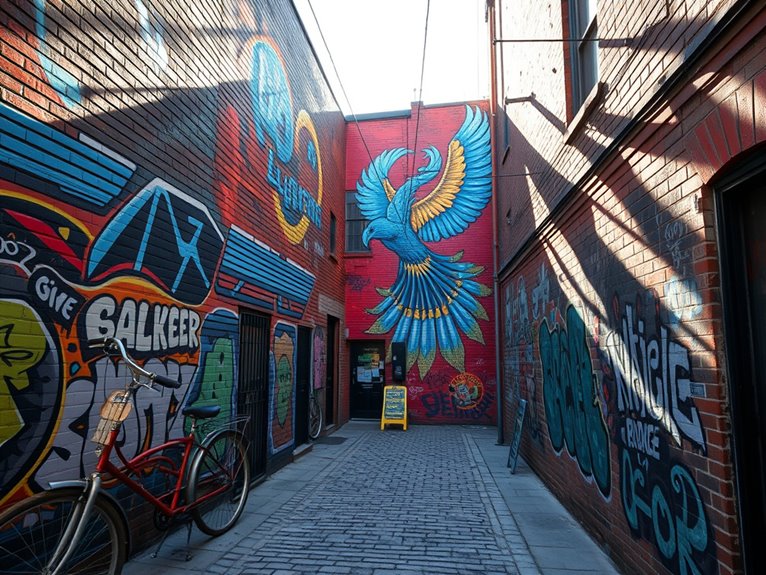
9 Street Art Locations in Paris for Urban Explorers
I've found nine incredible street art spots in Paris that'll blow your mind! Start at the 13th Arrondissement's open-air gallery, then explore Le Marais's hidden treasures and Belleville's cultural fusion. Don't miss Canal Saint-Martin's riverside murals, Rue Oberkampf's evolving canvas, and Montmartre's alternative scene. Butte-aux-Cailles offers village vibes, while Vitry-sur-Seine and Rue Dénoyez showcase legal graffiti zones. Each location reveals a different side of Paris's urban art movement!
The Open-Air Gallery of the 13th Arrondissement
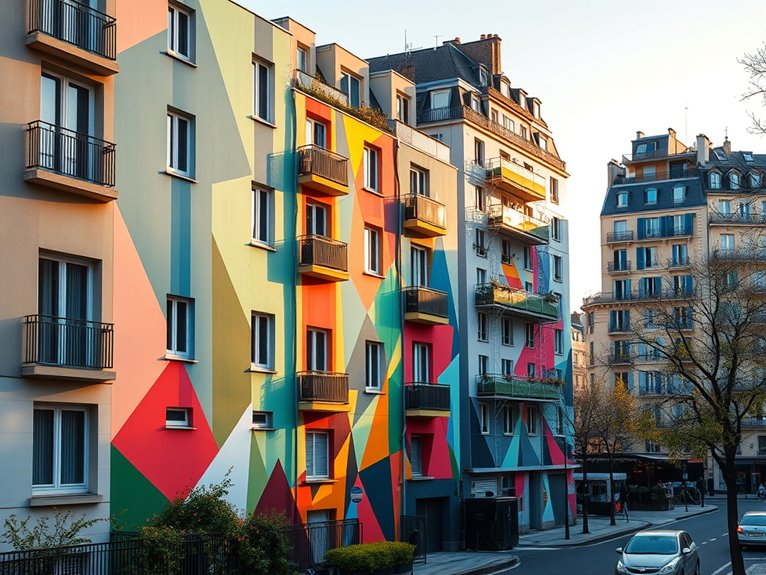
The 13th arrondissement of Paris has transformed from a modest residential district into one of Europe's largest open-air street art galleries. This extraordinary metamorphosis began in 2009 when the local government embraced urban art as a means of cultural revitalization, inviting renowned international artists to create massive murals on building facades.
Stretching across multiple neighborhoods, particularly around Boulevard Vincent Auriol and Rue Jeanne d'Arc, this dynamic outdoor museum features works by artists like Shepard Fairey, D*Face, and C215. The district showcases an ever-evolving collection of enormous murals, some reaching heights of 50 meters, creating an immersive experience where art becomes an integral part of the urban landscape.
Quick Facts:
- Best viewing hours: 10 AM – 4 PM for ideal lighting
- Cost: Free
- Photography: Wide-angle lens recommended
- Walking distance: Approximately 3-4 km for main circuit
- Weather consideration: Avoid rainy days for better visibility
- Guide availability: Free walking tours every Saturday morning
- Street art map: Available at 13th district town hall
Key Locations:
Boulevard Vincent Auriol
The main artery of the district's street art scene, featuring over 25 massive murals along the elevated metro line 6. Most works are visible from street level, with the best viewing spots marked by information plaques. The boulevard's arrangement allows for a natural walking circuit, with new pieces added regularly. Insider tip: Visit during early morning hours when traffic is minimal for unobstructed photos.
Place Jeanne d'Arc
A central hub where several significant murals converge, including works by Seth Globepainter and Faile. The square offers excellent vantage points for photographing multiple pieces simultaneously. The surrounding cafes provide perfect rest stops during exploration. Insider tip: The rooftop of the nearby Italie 2 shopping center offers unique elevated views of several murals.
Rue Nationale
Home to some of the district's most politically charged pieces, including works by Borondo and ROA. The street features smaller-scale murals that often incorporate architectural elements of buildings. Insider tip: Several hidden pieces exist in the perpendicular alleyways – look for small arrows painted on sidewalks leading to these hidden gems.
Pro Tips:
The ideal way to experience the 13th's street art is through a systematic exploration starting at Place d'Italie metro station and following Boulevard Vincent Auriol eastward. Photography enthusiasts should visit during the "golden hour" (one hour after sunrise or before sunset) when the light creates dramatic effects on the murals. Consider visiting during spring or fall when weather conditions are perfect and tourist crowds are thinner.
Practical Advice:
Download the "Street Art 13" app before visiting, as it provides real-time updates on new installations and removals. Comfortable walking shoes are essential, and carrying a portable charger is recommended for photo documentation. Many restaurants in the area close between lunch and dinner service, so plan refreshment stops accordingly. The district is generally safe, but as with any urban area, remain aware of your surroundings while photographing or walking with camera equipment.
Le Marais' Hidden Street Art Treasures
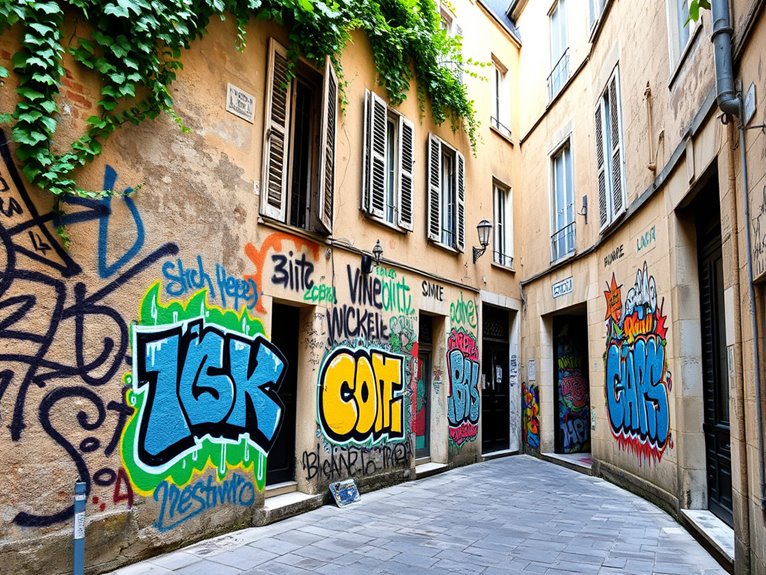
The historic Le Marais district, with its medieval architecture and aristocratic mansions, has evolved into one of Paris's most vibrant open-air galleries for street art. Behind its elegant facades and within its narrow cobblestone streets lies a dynamic collection of murals, stencils, and installations that represent both established and emerging artists from around the world.
This artistic treasure hunt through Le Marais reveals how contemporary urban art seamlessly integrates with centuries-old architecture, creating a unique cultural dialogue between past and present. From tiny paste-ups hidden in quiet corners to massive murals adorning entire building walls, the neighborhood offers an ever-changing exhibition that rewards careful observers and passionate art enthusiasts alike.
Quick Facts:
- Best viewing hours: 8:00-10:00 AM for ideal lighting and fewer crowds
- Cost: Free to explore
- Photography: Morning light best for east-facing walls; late afternoon for west-facing
- Walking time: 2-3 hours for thorough exploration
- Season: Year-round, but spring and fall offer perfect weather conditions
- Guide availability: Self-guided or organized tours (€15-30)
Rue Denoyez Gallery Wall
This legendary street serves as an ever-changing canvas where local artists regularly refresh their works. The entire length of the street features layers of graffiti, stencil art, and murals, creating a democratic space where emerging artists can showcase their talent. Located near the Belleville metro station, this living gallery is best visited during weekday mornings when artists often work on new pieces. Insider tip: Visit on Sundays when nearby cafes are open, allowing you to combine art viewing with traditional Marais brunch culture.
L'îlot 13 Collection
Hidden within a cluster of buildings around Rue Moret, this curated collection of commissioned murals represents some of Paris's finest contemporary street artists. The works range from political commentary to abstract designs, carefully preserved by local residents. Access is free, though some pieces require entering courtyards. Insider tip: The building manager at number 13 often allows access to a secret rooftop viewing point if asked politely during weekday afternoons.
Le Mur Street Art Space
This designated legal wall space features rotating exhibitions changed every two weeks. International and local artists are invited to create temporary installations, ensuring fresh content year-round. Located at the intersection of Rue Oberkampf and Rue Saint-Maur, this space has hosted works by renowned artists like Invader and Miss.Tic. Insider tip: Check the installation schedule online to witness artists at work during changeover weekends.
Pro Tips:
The best strategy for discovering Le Marais' street art is to combine main routes with spontaneous exploration of side streets. Early morning visits not only provide better lighting for photography but also reveal pieces that might be obscured by parked vehicles or market stalls later in the day. Downloading offline maps and marking key locations beforehand helps create an efficient route while leaving room for serendipitous discoveries.
Practical Advice:
Wear comfortable walking shoes and bring a camera with wide-angle lens capabilities for capturing larger murals in narrow streets. Many pieces are regularly painted over or modified, so photograph anything that catches your eye immediately. Consider joining local street art social media groups to stay updated on new installations and artist appearances. Respect private property and remember that while photography is generally welcomed, some building owners may request no commercial photography of their properties.
Belleville: Where Urban Art Meets Local Culture
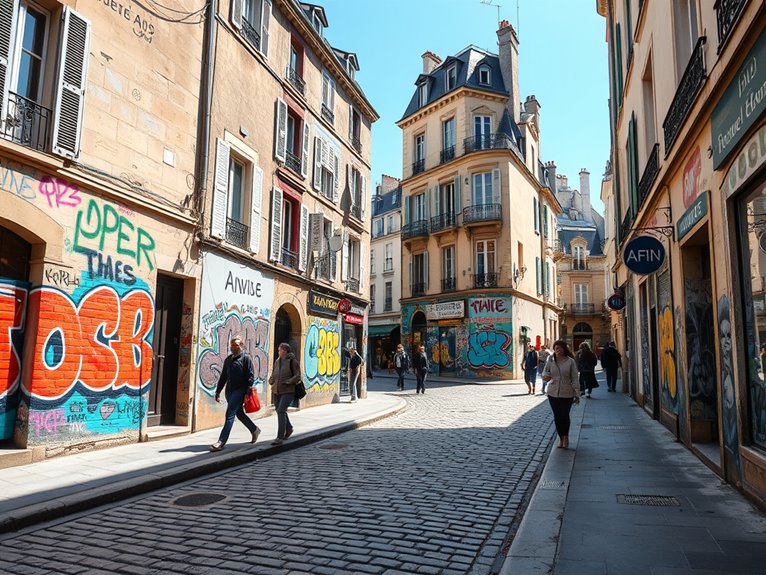
Nestled in Paris's 20th arrondissement, Belleville stands as a vibrant symbol of the city's contemporary art scene, where concrete walls transform into stunning canvases of expression. This multicultural neighborhood has evolved from its working-class roots into one of Paris's most dynamic street art destinations, attracting both established and emerging artists who contribute to its ever-changing outdoor gallery.
The area's artistic renaissance began in the 1980s and has since flourished into a haven for urban art enthusiasts, with works ranging from massive murals to subtle stencils hidden in quiet corners. Belleville's street art scene uniquely reflects the neighborhood's diverse cultural makeup, blending French artistic traditions with influences from its significant Chinese, North African, and Mediterranean communities.
Quick Facts:
- Best viewing times: 10 AM – 4 PM (ideal lighting for photos)
- Cost: Free to explore
- Photography: Permitted everywhere (tripods may require permission)
- Tour options: €15-30 for guided walks
- Peak seasons: Spring and Fall
- Weather consideration: Art is best viewed on dry days
- Walking difficulty: Moderate (some steep hills)
Key Street Art Locations:
Rue Dénoyez
A legendary street that serves as Belleville's street art epicenter, where artists have free reign to create and modify works. The entire street functions as a legal graffiti zone, with artwork changing weekly or even daily. Located near Belleville metro station, this living gallery is most active during weekends when local artists often work on new pieces.
Insider tip: Visit on Sunday mornings to catch artists in action and potentially engage in conversations about their work.
Le MUR Belleville
This dedicated art wall at 107 rue du Faubourg du Temple features curated works that change monthly. Professional artists are invited to create temporary installations, ensuring a constant rotation of high-quality street art. The wall's location near cafes makes it perfect for contemplating art while enjoying local culture.
Insider tip: Check their social media for installation dates to witness the creation process.
Rue Ramponeau
A quiet street hosting some of Belleville's most enduring murals, including works by international artists. The street's architectural layout creates natural frames for large-scale pieces, with some murals spanning several stories high. The gentle slope offers excellent vantage points for photography.
Insider tip: The morning light creates stunning shadows that add depth to the artworks.
Pro Tips:
For the most rewarding experience, explore Belleville's street art scene during weekday mornings when crowds are thin and lighting is ideal for photography. Consider starting at the Belleville metro station and working your way downhill, allowing gravity to assist your journey through the neighborhood's artistic landscape. Many pieces are tucked away in unexpected locations, so don't hesitate to explore side streets and passages.
Practical Advice:
Bring a detailed map or download an offline version, as the most interesting works are often off the main streets. Wear comfortable walking shoes and carry water, as the area's hills can be challenging. While the neighborhood is generally safe, keep your camera secure when not in use. Consider joining a local street art tour for your first visit to gain historical context and access to lesser-known spots that even regular visitors might miss.
Canal Saint-Martin's Riverside Masterpieces

The Canal Saint-Martin district has evolved into one of Paris's most vibrant open-air street art galleries, where industrial architecture meets creative expression. Along the waterway's edges, talented artists have transformed mundane walls and bridges into stunning murals, creating an ever-changing exhibition that reflects the neighborhood's bohemian spirit.
This 4.5-kilometer stretch of urban canvas attracts both established and emerging street artists, making it a must-visit destination for art enthusiasts and photographers. From massive building-sized murals to intimate stencil works tucked into hidden corners, the area offers an authentic glimpse into Paris's contemporary art scene while maintaining its working-class charm.
Quick Facts:
- Best viewing hours: 10 AM – 6 PM (optimal lighting for photos)
- Cost: Free to explore
- Photography: Morning light best for east-facing walls, afternoon for west-facing
- Walking distance: Approximately 2.5 hours for complete exploration
- Best seasons: Spring and Fall (fewer crowds, comfortable temperatures)
- Guide services available: Yes (€15-30 per person)
Rue de l'Hôpital Saint-Louis
This street serves as the gateway to the district's street art scene, featuring large-scale works by international artists. The highlight is a three-story mural depicting local life, created by French artist Seth. Located at the intersection with Quai de Jemmapes, the area is accessible via Goncourt metro station (Line 11). Visit early morning to avoid shadows from surrounding buildings.
Quai de Valmy
The western bank of the canal showcases an evolving collection of pieces, with new works appearing monthly. Notable spots include the "Rainbow Bridge" installation and several collaborative murals between local and international artists. The stretch between République and Stalingrad metro stations offers the highest concentration of artwork. Look for small signature tags near ground level – many famous artists leave their mark in unexpected places.
Rue Dieu
This narrow street houses some of the area's most photographed pieces, including works by Space Invader and Shepard Fairey. The street's industrial architecture provides a perfect backdrop for urban art. Located parallel to the canal, it's best visited during weekday afternoons when delivery trucks are gone. Search for the hidden courtyard at number 18 – it often features temporary installations not visible from the street.
Pro Tips:
The artwork along Canal Saint-Martin changes frequently, sometimes weekly. Follow local street art Instagram accounts to track new pieces and their locations. Photography enthusiasts should visit during the "blue hour" just after sunrise when the canal's water reflects the artwork, creating unique shooting opportunities. Consider joining a local art collective's walking tour for behind-the-scenes stories about the pieces and artists.
Practical Advice:
Wear comfortable walking shoes and bring a detailed map or download offline navigation, as many works are tucked away in side streets. While photographing, respect local businesses and residents – some areas are private property. Many cafes along the route welcome art viewers, but purchase something if you plan to use their facilities. Keep an eye on your belongings, as the area gets crowded during peak times.
Rue Oberkampf's Ever-Changing Canvas
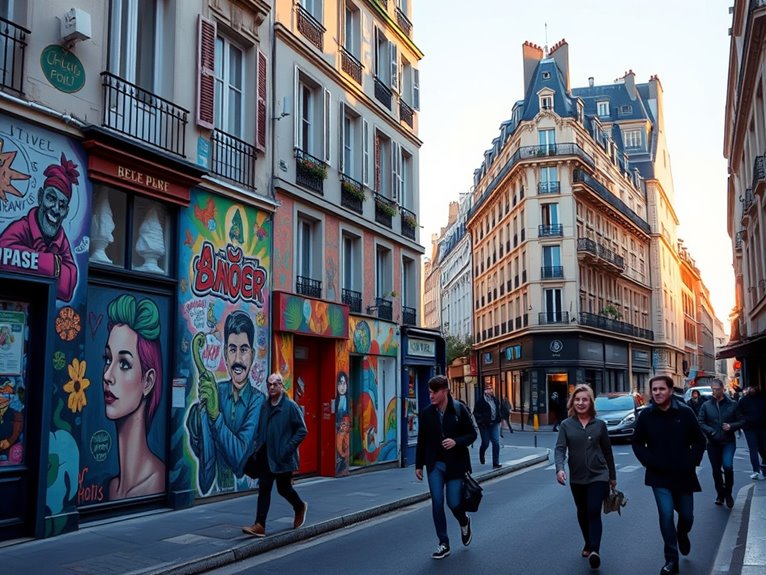
Rue Oberkampf stands as one of Paris's most dynamic open-air galleries, where concrete walls transform into vibrant canvases showcasing the city's thriving street art scene. This bustling street in the 11th arrondissement has evolved from its working-class roots into a cultural hub where internationally renowned artists and emerging talents alike leave their mark on the urban landscape.
What sets Rue Oberkampf apart is its constant evolution – artwork that appears one week might be replaced by something entirely different the next. This perpetual transformation makes every visit unique, offering glimpses into Paris's contemporary art movement while reflecting the neighborhood's creative spirit and social commentary.
Quick Facts:
- Best viewing hours: 10:00 AM – 4:00 PM for ideal lighting
- Cost: Free
- Photography: Permitted, morning light best for minimal glare
- Length: Approximately 1.2 kilometers of art-rich streetscape
- Peak times: Weekday afternoons have fewer pedestrians
- Notable intersection: Le MUR (The Wall) at Rue Saint-Maur
Key Street Art Locations:
Le MUR (The Wall)
This authorized art space at the intersection of Rue Saint-Maur features curated works that change every two weeks. International artists receive official invitations to create pieces here, making it a prestigious spot in the street art world. The wall measures 8×3 meters and has hosted works by over 250 artists since 2007. Insider tip: Check Le MUR's social media accounts for installation dates to watch artists at work.
Café Le Pure
The exterior walls of this local café serve as an unofficial gallery space where pieces tend to remain longer than in other spots. Multiple layers of past artwork create unique palimpsests, telling the street's artistic history. Located at 86 Rue Oberkampf, the café offers excellent vantage points for photography while enjoying local cuisine. Insider tip: The owner maintains a photo archive of past murals – ask politely to view it.
Pro Tips:
For the best street art experience, visit during weekday mornings when businesses are opening their shutters, revealing hidden artworks painted on them. Many pieces are created at night, so early morning visits often yield fresh discoveries. Consider joining local street art walking tours led by artists themselves, offering behind-the-scenes insights into the neighborhood's creative process and history.
Practical Advice:
Bring a camera with wide-angle capabilities to capture larger murals, and consider returning at different times of day as changing light conditions dramatically affect how the artwork appears. While most areas are safe, remain aware of your surroundings when photographing, and respect private property boundaries. Local businesses generally welcome photographers but ask permission before capturing their storefronts up close.
Montmartre's Alternative Art Scene
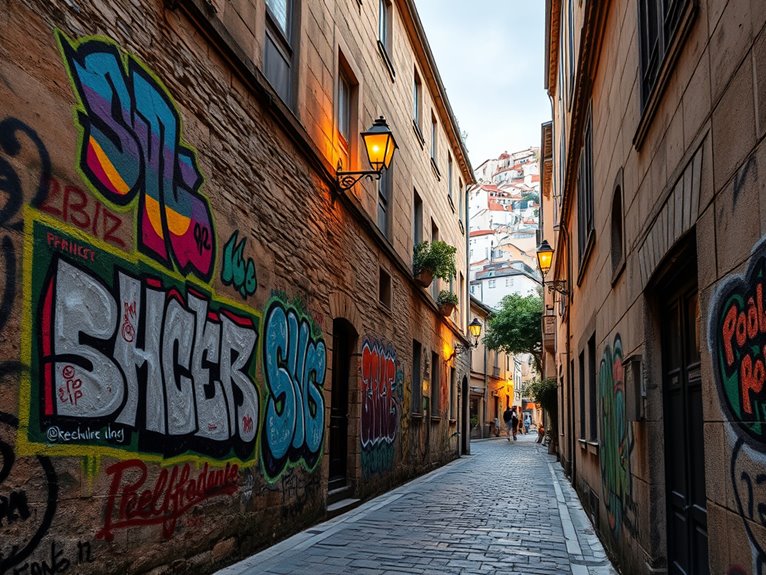
Beyond the iconic white domes of Sacré-Cœur and the tourist-filled Place du Tertre lies a vibrant, underground art scene that pulses through Montmartre's winding streets. This historic artists' quarter, once home to luminaries like Picasso and Van Gogh, continues its creative legacy through a thriving street art movement that transforms ordinary walls into extraordinary canvases.
The alternative art scene in Montmartre offers a striking contrast to the neighborhood's traditional artistic reputation. While painters still set up their easels in squares to capture scenic views, a new generation of artists uses spray cans, stencils, and wheat paste to create powerful contemporary statements on building facades, staircases, and hidden corners.
Quick Facts:
- Best viewing times: Early morning (7-9 AM) for ideal lighting and fewer tourists
- Cost: Free to explore
- Photography: Wide-angle lens recommended; morning light best for east-facing walls
- Walking difficulty: Moderate (steep hills and stairs)
- Peak street art season: March to October
- Guide availability: Self-guided or organized tours (€15-30)
Rue de l'Abreuvoir
This picturesque street hosts some of Montmartre's most photographed street art installations, including the famous "Love Wall" by Frederic Baron. The wall features "I love you" written in 250 languages, creating a powerful statement about universal connection. Located near Place Dalida, this street is best visited before 10 AM to avoid tourist crowds. Insider tip: Look for the small ceramic tiles embedded in building corners – they're part of a secret art installation project started in 2018.
Place Dalida
A convergence point for contemporary street artists, this square features ever-changing murals and paste-ups. The area around the Dalida bust statue has become an unofficial gallery for emerging artists. Open 24/7, but the area is best explored during daylight hours. Watch for the "ghost signs" – restored vintage advertisements that local artists have incorporated into new works.
Rue des Trois Frères
This steep street showcases political and social commentary through stencil art and murals. The narrow passage contains works by both international and local artists, with pieces changing frequently. Most notable is the "Butterfly Effect" series spanning several buildings. Insider tip: The best pieces are often found in the small passages branching off the main street.
Pro Tips:
The alternative art scene in Montmartre is most active during the first Sunday of each month when local artists often create new pieces. Photography enthusiasts should carry both wide-angle and macro lenses, as some of the most interesting works are small-scale installations hidden in unexpected places. Consider joining local art groups on social media to learn about new installations and temporary exhibitions.
Practical Advice:
Respect private property and only photograph publicly visible art. Many pieces are temporary or change frequently, so don't be disappointed if specific works mentioned in older guides are no longer present. Carry a detailed map as mobile reception can be spotty in some narrow streets. Most importantly, wear comfortable walking shoes with good grip, as Montmartre's hills and cobblestone streets can be challenging to navigate.
Butte-aux-Cailles: Street Art in the Village
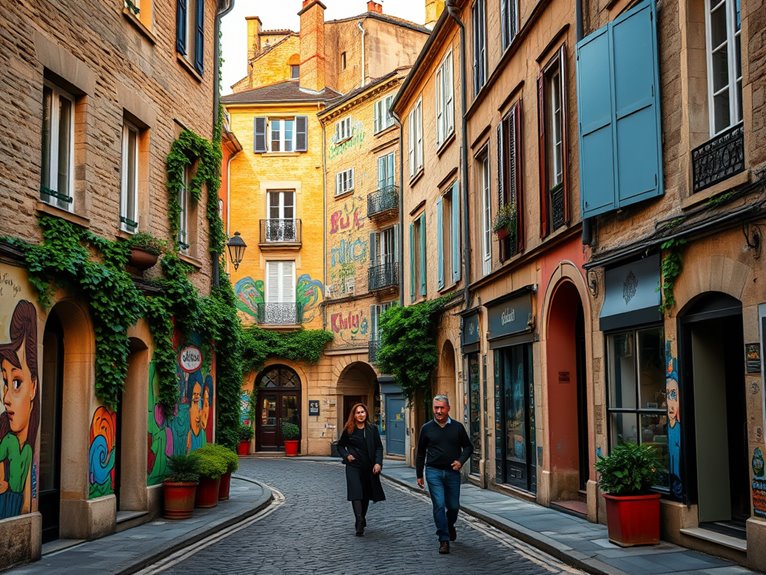
Nestled in the 13th arrondissement of Paris, Butte-aux-Cailles stands as a charming village-like neighborhood that has become one of the city's most vibrant street art destinations. This historic working-class district, with its cobblestone streets and small houses, provides the perfect canvas for both established and emerging street artists to showcase their creativity.
The area's artistic transformation began in the 1980s and has since evolved into an open-air gallery featuring everything from large-scale murals to intimate stencil works. Unlike the more tourist-heavy areas of Paris, Butte-aux-Cailles maintains its authentic local atmosphere while hosting some of the city's most impressive street art collections.
Quick Facts:
- Best viewing hours: 10:00 AM – 6:00 PM (ideal lighting for photos)
- Cost: Free to explore
- Walking time needed: 2-3 hours for a complete tour
- Photography: Permitted everywhere (some works best captured in morning light)
- Guide services available: Yes (€15-30 per person)
- Accessibility: Moderate hills and stairs throughout the area
Notable Street Art Locations:
Rue des Cinq Diamants
The main artery of Butte-aux-Cailles features an ever-changing gallery of works by both local and international artists. Notable pieces include Seth Globepainter's signature characters and Miss.Tic's poetic stencils. Look for the hidden works in the small passages branching off the main street.
Insider tip: The street's art changes frequently, so visiting every few months reveals new pieces.
Place Paul Verlaine
This square serves as a hub for larger murals, with works often spanning entire building facades. The area is particularly known for its political and social commentary pieces. Open 24/7, but best viewed during daylight hours.
Insider tip: The nearby Art Nouveau swimming pool provides an interesting architectural contrast to the modern street art.
Rue de l'Espérance
A concentrated collection of stencil art and smaller pieces lines this atmospheric street. Artists frequently choose this location for its intimate scale and strong community feel. The street is especially picturesque during early morning or sunset hours.
Insider tip: Several pieces are hidden in the doorways – don't hesitate to peek into open passages.
Pro Tips:
Morning visits offer the best photography opportunities as the crowds are thinner and the light is ideal for capturing the vibrant colors of the artworks. Consider visiting on weekdays to avoid the weekend crowds when local cafes and restaurants are busiest. Combining your street art exploration with a morning coffee at one of the area's traditional cafés provides an authentic local experience.
Practical Advice:
Wear comfortable walking shoes as the neighborhood's hills can be challenging. Bring a detailed map or download an offline version, as the area's winding streets can be confusing for first-time visitors. Many works are unmarked, so consider joining a guided tour for deeper insight into the artists and their works. Most importantly, respect the residential nature of the area by keeping noise levels down and avoiding flash photography near homes.
Vitry-sur-Seine: The Street Art Museum City
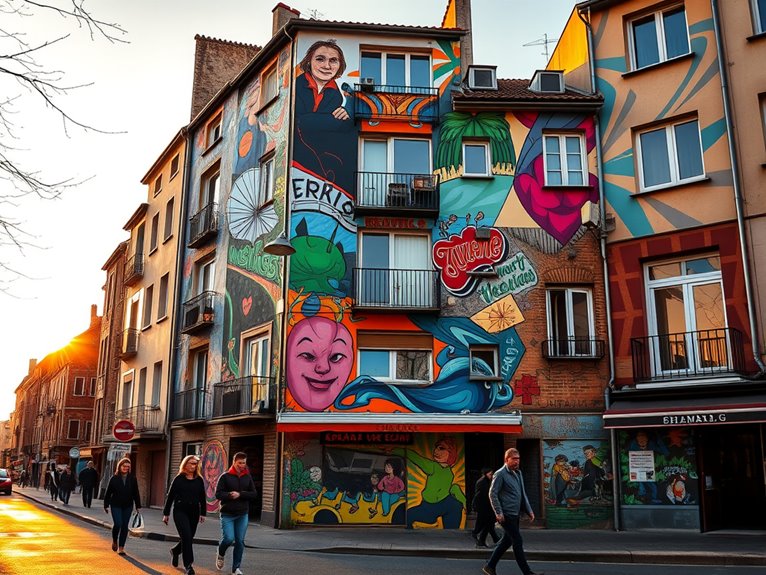
Located in the southern suburbs of Paris, Vitry-sur-Seine has transformed itself into one of Europe's most impressive open-air street art galleries. This working-class commune has embraced urban art as a core part of its identity, with over 100 large-scale murals and countless smaller works adorning its buildings, making it a must-visit destination for art enthusiasts and photographers alike.
The city's street art revolution began in 2009 when the local government actively invited international artists to leave their mark on its walls. Today, Vitry-sur-Seine stands as a living embodiment of the evolution of street art, featuring works by renowned artists like C215, Cope2, and Nunca, alongside emerging local talents who continue to add fresh perspectives to the urban landscape.
Quick Facts:
- Best visiting hours: 10 AM – 4 PM for ideal lighting
- Cost: Free to explore
- Photography: Early morning or late afternoon for best light
- Walking time: 2-3 hours for main circuit
- Guided tours: Available on weekends (€15-25)
- Accessibility: Multiple RER C stations nearby
- Best season: Spring through fall for comfortable walking
MAC VAL Area
The Museum of Contemporary Art Val-de-Marne (MAC VAL) neighborhood serves as the epicenter of Vitry's street art scene. Large-scale murals surround the museum, creating an artistic dialogue between institutional and street art. Located at Place de la Libération, this area features works that change regularly, keeping the experience fresh for repeat visitors.
Insider tip: The museum's café offers an excellent vantage point for photographing several major pieces while enjoying local cuisine.
Rue Jean Jaurès Circuit
This main street showcases some of the city's most iconic works, including C215's signature stencil portraits. The 1.5-kilometer stretch features pieces that range from political commentary to abstract designs. Many works are integrated with local architecture, creating unique perspectives that change throughout the day.
Insider tip: The stretch between numbers 43-71 contains the highest concentration of works.
Avenue du Groupe Manouchian
Known for its monumental murals, this avenue demonstrates how street art can transform industrial architecture. The massive walls of residential buildings serve as canvases for internationally acclaimed artists. Several pieces here address social issues and local history.
Insider tip: Visit during golden hour when the setting sun creates dramatic shadows across the murals.
Pro Tips:
Street art in Vitry-sur-Seine is best explored with a flexible itinerary, as new works appear regularly and some may be temporary. Download the "Vitry Street Art" app before visiting, as it provides an updated map and information about artists and works. Consider joining a weekend guided tour led by local artists for insider knowledge about the creation process and hidden gems.
Practical Advice:
While Vitry-sur-Seine is generally safe, visitors should stick to main streets and respect private property when photographing artwork. Bring comfortable walking shoes and a wide-angle lens for photography. The best approach is to start at MAC VAL and work outward in a circular route. Most cafés and restaurants in the area accept credit cards, but carrying some cash is advisable for small purchases. Remember that some works may be in active residential areas, so maintain appropriate noise levels and respect local residents.
Rue Dénoyez: The Legal Graffiti Corridor
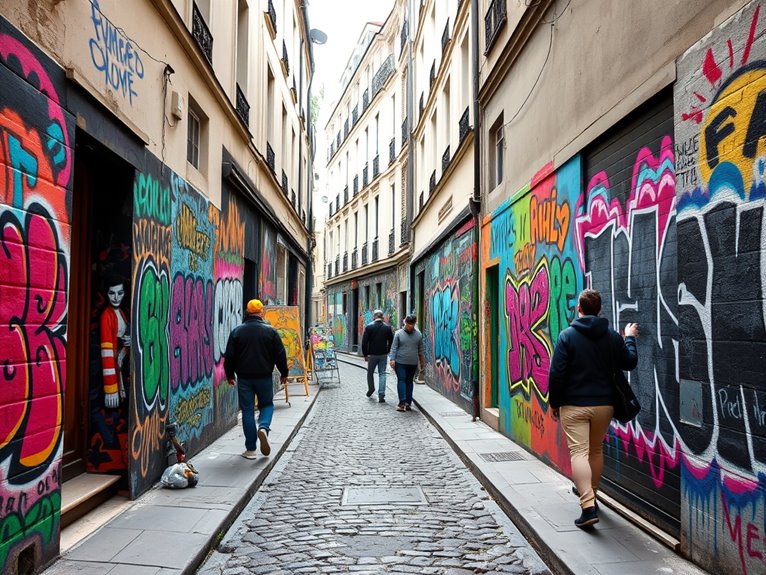
Tucked away in the vibrant Belleville neighborhood of Paris's 20th arrondissement, Rue Dénoyez stands as a demonstration of the city's embrace of street art culture. This narrow street has transformed from a typical Parisian alley into an ever-changing canvas where artists can legally express their creativity, making it one of the few sanctioned spaces for street art in the French capital.
Unlike other street art locations that require stealth and secrecy, Rue Dénoyez offers artists and viewers a unique opportunity to experience the creation and evolution of urban art in broad daylight. The 150-meter stretch has become a living gallery where works change weekly or even daily, showcasing everything from political statements to abstract masterpieces, all while maintaining a distinctly Parisian character.
Quick Facts:
- Best viewing times: 10 AM – 4 PM (optimal lighting)
- Cost: Free
- Photography: Permitted and encouraged
- Active painting times: Typically weekends
- Length of street: 150 meters
- Nearest Metro: Belleville (Lines 2 and 11)
- Best days: Tuesday-Thursday (fewer crowds)
The Street Gallery
The heart of Rue Dénoyez runs from Rue de Belleville to Rue Ramponeau, featuring constantly rotating murals on both sides of the street. Building owners have officially agreed to allow their walls to serve as canvases, creating a unique ecosystem where artists respect each other's work while continuously adding new layers to the street's artistic narrative. Insider tip: Visit multiple times during your stay in Paris, as the artwork can change dramatically even within a few days.
The Artist Community
The street has become a gathering point for both established and emerging artists, particularly on weekends when multiple creators can be seen at work. Many are willing to discuss their pieces and techniques with interested observers, providing a rare glimpse into the street art creation process. Local artists often gather at the nearby Aux Folies café, which itself sports some remarkable exterior artwork.
Cultural Significance
Rue Dénoyez represents a successful marriage between street art culture and municipal authorization, serving as a model for other cities worldwide. The street has played a significant role in legitimizing street art in Paris, leading to broader acceptance and support for urban art initiatives throughout the city. The corridor has been featured in numerous art publications and documentaries about Parisian street culture.
Pro Tips:
Morning visits offer the best natural lighting for photography, while afternoons tend to be busier with artists at work. Consider bringing a wide-angle lens to capture entire murals in the narrow street. For the most authentic experience, visit during weekend afternoons when local artists are most likely to be creating new pieces. Engage with artists respectfully, and always ask permission before photographing them at work.
Practical Considerations:
While exploring Rue Dénoyez, respect the artists' work space and avoid touching fresh paint. The area is generally safe but remain aware of your surroundings, particularly when using expensive camera equipment. Several excellent cafés and restaurants in the vicinity make it easy to combine your street art exploration with authentic local dining experiences. Wear comfortable shoes as the street and surrounding area feature typical Parisian cobblestones.
